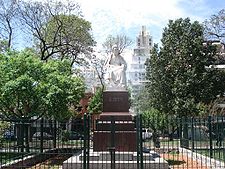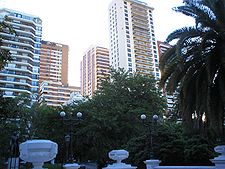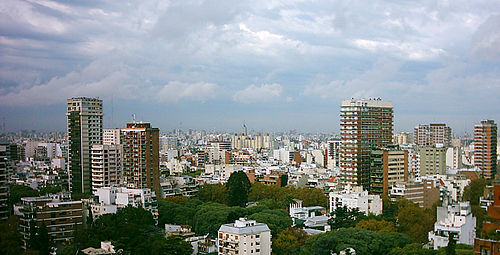
Belgrano, Buenos Aires
Encyclopedia
Belgrano is a leafy, northern barrio or neighborhood of the city of Buenos Aires
, Argentina
.
is to the southeast; Nuñez
is to the northwest; Coghlan
, Villa Urquiza
, Villa Ortúzar
and Colegiales
are to the southwest.
, a politician and military leader who created the national flag of Argentina
.
In 1820, at Belgrano's death, Buenos Aires
' legislature introduced a law to name the next town to be founded after him. This happened in 1855, when the Buenos Aires government, fearful that relatives of Juan Manuel de Rosas
would dispute the governmental decision to expropriate Rosas' lands, laid down a new town on part of it and named it Belgrano. The town was declared a city shortly thereafter, due to its booming growth, and in 1880 it became the nation's capital for a few weeks, because of the dispute between the national government and Buenos Aires province for the status of the city of Buenos Aires. It was in Belgrano that the law declaring Buenos Aires as Argentina's federal capital was issued.
 In 1887, the federal district was enlarged by the annexation of the towns (partidos) of Belgrano and Flores
In 1887, the federal district was enlarged by the annexation of the towns (partidos) of Belgrano and Flores
.
Belgranodeutsch
or Belgrano-Deutsch is a mixture of German
and Spanish
spoken in Buenos Aires
, specifically in the neighborhood of Belgrano.
 Belgrano is an upper-middle class neighborhood that can be roughly divided into Belgrano R, Belgrano C, central Belgrano, and Lower Belgrano (Bajo Belgrano). The heart of the barrio pulses with life on its main thoroughfare, Avenida Cabildo, which runs Northwest to Southeast; the subway
Belgrano is an upper-middle class neighborhood that can be roughly divided into Belgrano R, Belgrano C, central Belgrano, and Lower Belgrano (Bajo Belgrano). The heart of the barrio pulses with life on its main thoroughfare, Avenida Cabildo, which runs Northwest to Southeast; the subway
(subte) Line D
follows its route.
Avenida Cabildo carries heavy automobile traffic, and features corner cafés, grocery stores, movie theaters, specialty shops, clothing boutiques, bookstores, and other retail venues. Pedestrians are especially numerous on weekend afternoons as Porteños (residents of Buenos Aires) from various areas of the city come to shop.
Most of the neighborhood's densest housing is located in the vicinity of Cabildo. High-rise luxury apartment buildings are clustered on the leafy streets surrounding the Universidad de Belgrano, a private liberal-arts university.
 West of Crámer avenue, "Belgrano R" is chiefly residential and lower-density in nature, characterized by calm streets lined with large, mature shade trees. Most buildings in this section are detached single-family homes that follow Anglo-Saxon architectural styles; some residences have sizable backyards with swimming pools. This section is favored by wealthy Argentines and expatriate businesspeople.
West of Crámer avenue, "Belgrano R" is chiefly residential and lower-density in nature, characterized by calm streets lined with large, mature shade trees. Most buildings in this section are detached single-family homes that follow Anglo-Saxon architectural styles; some residences have sizable backyards with swimming pools. This section is favored by wealthy Argentines and expatriate businesspeople.
"Belgrano C
" is also home to Buenos Aires's small Chinatown
. The district is crowded with restaurants and specialty grocery stores catering to Asian-Argentines and to the general public.
Belgrano's sidewalks are often busy with dogwalkers. Even though city ordinances forbid more than ten dogs to a person, it is not uncommon to see double that number—which contributes to the dog-waste problem plaguing many sidewalks.
, many bus lines (notably Colectivo 60
), and two commuter rail lines. Approximately 1.5 km to the west of Belgrano lies Avenida General Paz
, a major limited-access freeway that defines the city limits of Buenos Aires proper. Beyond this avenue lie the suburbs of Vicente Lopez, Florida and Olivos.

, who designed many open spaces throughout Buenos Aires. Several blocks north of the Belgrano University, Barrancas de Belgrano spans several city blocks and is overlooked by highrise upper-middle class apartment buildings.
On Manuel Belgrano square, a local artisan fair is held regularly, and becomes especially vibrant on weekends. It features a small bust of Manuel Belgrano
on its middle spot.
In the edge of the plaza lies the Inmaculada Concepción church, called "La Redonda" (the round one) by locals because of its circular plan. Many weddings are celebrated in this church in the afternoon hours. Two museums are also across Juramento and Cuba streets: Larreta and Sarmiento, respectively. Larreta museum focus on Spanish art. It is located on the former private residence of writer Enrique Larreta
, designed by architect Ernesto Bunge on 1882. It features a well kept Andalusian garden. Historical Museum Sarmiento exhibits some objects belonging to former presidents Domingo Faustino Sarmiento
and Nicolás Avellaneda
. It is located in what used to be Belgrano townhall, where the national congress held its sessions while Belgrano was the capital of the republic. Although neighboring Nuñez
is widely known as the home of River Plate
landmark stadium El Monumental (also home of the national team Argentina national football team
) is located within Belgrano boundaries.


Buenos Aires
Buenos Aires is the capital and largest city of Argentina, and the second-largest metropolitan area in South America, after São Paulo. It is located on the western shore of the estuary of the Río de la Plata, on the southeastern coast of the South American continent...
, Argentina
Argentina
Argentina , officially the Argentine Republic , is the second largest country in South America by land area, after Brazil. It is constituted as a federation of 23 provinces and an autonomous city, Buenos Aires...
.
Location
The barrio of PalermoPalermo, Buenos Aires
Palermo is a neighborhood, or barrio of the Argentine capital, Buenos Aires. It is located in the northeast of the city, bordering the barrios of Belgrano to the north, Almagro and Recoleta to the south, Villa Crespo and Colegiales to the west and the Río de la Plata river to the east. With a total...
is to the southeast; Nuñez
Núñez, Buenos Aires
Núñez is a barrio or neighbourhood of Buenos Aires, Argentina. It is on the northern edge of the city on the banks of the Rio de la Plata.The barrio of Belgrano is to the southeast; Saavedra and Coghlan are to the west; and Vicente López, in Buenos Aires Province, is to the north.The borough has an...
is to the northwest; Coghlan
Coghlan, Buenos Aires
Coghlan is a barrio , of the city of Buenos Aires, Argentina.It is the name of a middle class neighbourhood located between Belgrano, Saavedra, Núñez and Villa Urquiza; it was originally inhabited by Irish and English immigrants....
, Villa Urquiza
Villa Urquiza
Villa Urquiza is a barrio or neighborhood of Buenos Aires city, capital of Argentina. It is located between the barrios of Villa Pueyrredón, Belgrano, Villa Ortúzar, Coghlan, Saavedra and Agronomía. Its limits are the streets and avenues Constituyentes, Crisólogo Larralde, Galván, Núñez, Tronador,...
, Villa Ortúzar
Villa Ortúzar
Villa Ortúzar is one of the neighbourhoods of Buenos Aires. Its limits are La Pampa St., Forest Ave., Elcano Ave., Ferrocarril General Urquiza railroads, Del Campo Ave., Combatientes de Malvinas Ave. and Triunvirato Ave....
and Colegiales
Colegiales
Colegiales is a barrio or district in Buenos Aires, Argentina. It is located between Alvarez Thomas av., Forest av., De los Incas av., Virrey del Pino st., Cabildo av., Jorge Newbery st., Crámer st. and Dorrego av. This neighbourhood offers a vast amount of contrast and opportunities...
are to the southwest.
History
Belgrano was named after Manuel BelgranoManuel Belgrano
Manuel José Joaquín del Corazón de Jesús Belgrano , usually referred to as Manuel Belgrano, was an Argentine economist, lawyer, politician, and military leader. He took part in the Argentine Wars of Independence and created the Flag of Argentina...
, a politician and military leader who created the national flag of Argentina
Flag of Argentina
The national flag of Argentina is a triband, composed of three equally wide horizontal bands coloured light blue, white and light blue. There are multiple interpretations on the reasons for those colors...
.
In 1820, at Belgrano's death, Buenos Aires
Buenos Aires Province
The Province of Buenos Aires is the largest and most populous province of Argentina. It takes the name from the city of Buenos Aires, which used to be the provincial capital until it was federalized in 1880...
' legislature introduced a law to name the next town to be founded after him. This happened in 1855, when the Buenos Aires government, fearful that relatives of Juan Manuel de Rosas
Juan Manuel de Rosas
Juan Manuel de Rosas , was an argentine militar and politician, who was elected governor of the province of Buenos Aires in 1829 to 1835, and then of the Argentine Confederation from 1835 until 1852...
would dispute the governmental decision to expropriate Rosas' lands, laid down a new town on part of it and named it Belgrano. The town was declared a city shortly thereafter, due to its booming growth, and in 1880 it became the nation's capital for a few weeks, because of the dispute between the national government and Buenos Aires province for the status of the city of Buenos Aires. It was in Belgrano that the law declaring Buenos Aires as Argentina's federal capital was issued.

Flores, Buenos Aires
Flores is a middle class barrio or district in the centre part of Buenos Aires city, Argentina. Flores was considered a rural area of the Province of Buenos Aires until 1888 when it was integrated to the City....
.
Belgranodeutsch
Belgranodeutsch
Belgranodeutsch or Belgrano-Deutsch is a mixture of German and Spanish spoken in Buenos Aires, specifically in the neighborhood of Belgrano.It was spoken by the German community living in both Belgrano "R" and Belgrano "C" ....
or Belgrano-Deutsch is a mixture of German
German language
German is a West Germanic language, related to and classified alongside English and Dutch. With an estimated 90 – 98 million native speakers, German is one of the world's major languages and is the most widely-spoken first language in the European Union....
and Spanish
Spanish language
Spanish , also known as Castilian , is a Romance language in the Ibero-Romance group that evolved from several languages and dialects in central-northern Iberia around the 9th century and gradually spread with the expansion of the Kingdom of Castile into central and southern Iberia during the...
spoken in Buenos Aires
Buenos Aires
Buenos Aires is the capital and largest city of Argentina, and the second-largest metropolitan area in South America, after São Paulo. It is located on the western shore of the estuary of the Río de la Plata, on the southeastern coast of the South American continent...
, specifically in the neighborhood of Belgrano.
Subsections

Rapid transit
A rapid transit, underground, subway, elevated railway, metro or metropolitan railway system is an electric passenger railway in an urban area with a high capacity and frequency, and grade separation from other traffic. Rapid transit systems are typically located either in underground tunnels or on...
(subte) Line D
Line D (Buenos Aires)
Line D of the Buenos Aires Metro runs from Catedral to Congreso de Tucumán. The D Line opened on 3 June 1937 and has been expanded to the north several times. The line is currently 10.41 km long and runs approximately parallel to the city's coastline....
follows its route.
Avenida Cabildo carries heavy automobile traffic, and features corner cafés, grocery stores, movie theaters, specialty shops, clothing boutiques, bookstores, and other retail venues. Pedestrians are especially numerous on weekend afternoons as Porteños (residents of Buenos Aires) from various areas of the city come to shop.
Most of the neighborhood's densest housing is located in the vicinity of Cabildo. High-rise luxury apartment buildings are clustered on the leafy streets surrounding the Universidad de Belgrano, a private liberal-arts university.

"Belgrano C
Belgrano C
Belgrano C is a sector within the barrio of Belgrano of Buenos Aires, Argentina, and is not officially recognised as one of the 48 barrios of Buenos Aires....
" is also home to Buenos Aires's small Chinatown
Chinatown, Buenos Aires
The area known as Chinatown in Buenos Aires is a largely commercial section about five blocks long in the barrio of Belgrano, Buenos Aires. The Asian community living in Belgrano is less than 0.5% of the ward's total...
. The district is crowded with restaurants and specialty grocery stores catering to Asian-Argentines and to the general public.
Belgrano's sidewalks are often busy with dogwalkers. Even though city ordinances forbid more than ten dogs to a person, it is not uncommon to see double that number—which contributes to the dog-waste problem plaguing many sidewalks.
Transportation
Other than Cabildo, avenues Libertador, Luis Maria Campos, Crámer, Ricardo Balbín (formerly known as del Tejar), and Figueroa Alcorta run parallel to the riverbank, while Federico Lacroze, Juramento, Monroe and Congreso run from the riverbank to the Southwest direction. Belgrano is served by the Buenos Aires metro line DLine D (Buenos Aires)
Line D of the Buenos Aires Metro runs from Catedral to Congreso de Tucumán. The D Line opened on 3 June 1937 and has been expanded to the north several times. The line is currently 10.41 km long and runs approximately parallel to the city's coastline....
, many bus lines (notably Colectivo 60
Colectivo 60
The Colectivo 60 runs from Constitución station, in the centre of the city of Buenos Aires, Argentina to the Tigre Club in the partido of Tigre...
), and two commuter rail lines. Approximately 1.5 km to the west of Belgrano lies Avenida General Paz
Avenida General Paz
Avenida General Paz is a beltway freeway surrounding the city of Buenos Aires. Roughly following the boundary between the city and Buenos Aires Province, it is one of the few motorways in Argentina that is toll-free...
, a major limited-access freeway that defines the city limits of Buenos Aires proper. Beyond this avenue lie the suburbs of Vicente Lopez, Florida and Olivos.

Notable Attractions
The lush park Barrancas de Belgrano was designed by the famous French-Argentine landscape/park architect Carlos ThaysCarlos Thays
Carlos Thays was a French-Argentine landscape architect, and a student of French landscape architect Édouard André.-Biography:...
, who designed many open spaces throughout Buenos Aires. Several blocks north of the Belgrano University, Barrancas de Belgrano spans several city blocks and is overlooked by highrise upper-middle class apartment buildings.
On Manuel Belgrano square, a local artisan fair is held regularly, and becomes especially vibrant on weekends. It features a small bust of Manuel Belgrano
Manuel Belgrano
Manuel José Joaquín del Corazón de Jesús Belgrano , usually referred to as Manuel Belgrano, was an Argentine economist, lawyer, politician, and military leader. He took part in the Argentine Wars of Independence and created the Flag of Argentina...
on its middle spot.
In the edge of the plaza lies the Inmaculada Concepción church, called "La Redonda" (the round one) by locals because of its circular plan. Many weddings are celebrated in this church in the afternoon hours. Two museums are also across Juramento and Cuba streets: Larreta and Sarmiento, respectively. Larreta museum focus on Spanish art. It is located on the former private residence of writer Enrique Larreta
Enrique Larreta
Enrique Rodríguez Larreta was an Argentine writer, academic, diplomat and art collector.-Biography:Larreta was born in Buenos Aires to Adela Maza and Carlos Rodríguez Larreta...
, designed by architect Ernesto Bunge on 1882. It features a well kept Andalusian garden. Historical Museum Sarmiento exhibits some objects belonging to former presidents Domingo Faustino Sarmiento
Domingo Faustino Sarmiento
Domingo Faustino Sarmiento was an Argentine activist, intellectual, writer, statesman and the seventh President of Argentina. His writing spanned a wide range of genres and topics, from journalism to autobiography, to political philosophy and history...
and Nicolás Avellaneda
Nicolás Avellaneda
Nicolás Remigio Aurelio Avellaneda Silva was an Argentine politician and journalist, and president of Argentina from 1874 to 1880. Avellaneda's main projects while in office were banking and education reform, leading to Argentina's economic growth...
. It is located in what used to be Belgrano townhall, where the national congress held its sessions while Belgrano was the capital of the republic. Although neighboring Nuñez
Nunez
Nunez is a Spanish surname. The Portuguese variant is Nunes. Notable people with the name include:-Academica:* Antonio Núñez Jiménez, Cuban revolutionary and academic...
is widely known as the home of River Plate
Club Atlético River Plate
Club Atlético River Plate is an Argentine sports club based in the Nuñez neighborhood of Buenos Aires. It is best known for its professional football team, which currently competes in Nacional B, the second tier of Argentine football....
landmark stadium El Monumental (also home of the national team Argentina national football team
Argentina national football team
The Argentina national football team represents Argentina in association football and is controlled by the Argentine Football Association , the governing body for football in Argentina. Argentina's home stadium is Estadio Monumental Antonio Vespucio Liberti and their head coach is Alejandro...
) is located within Belgrano boundaries.

Image gallery


